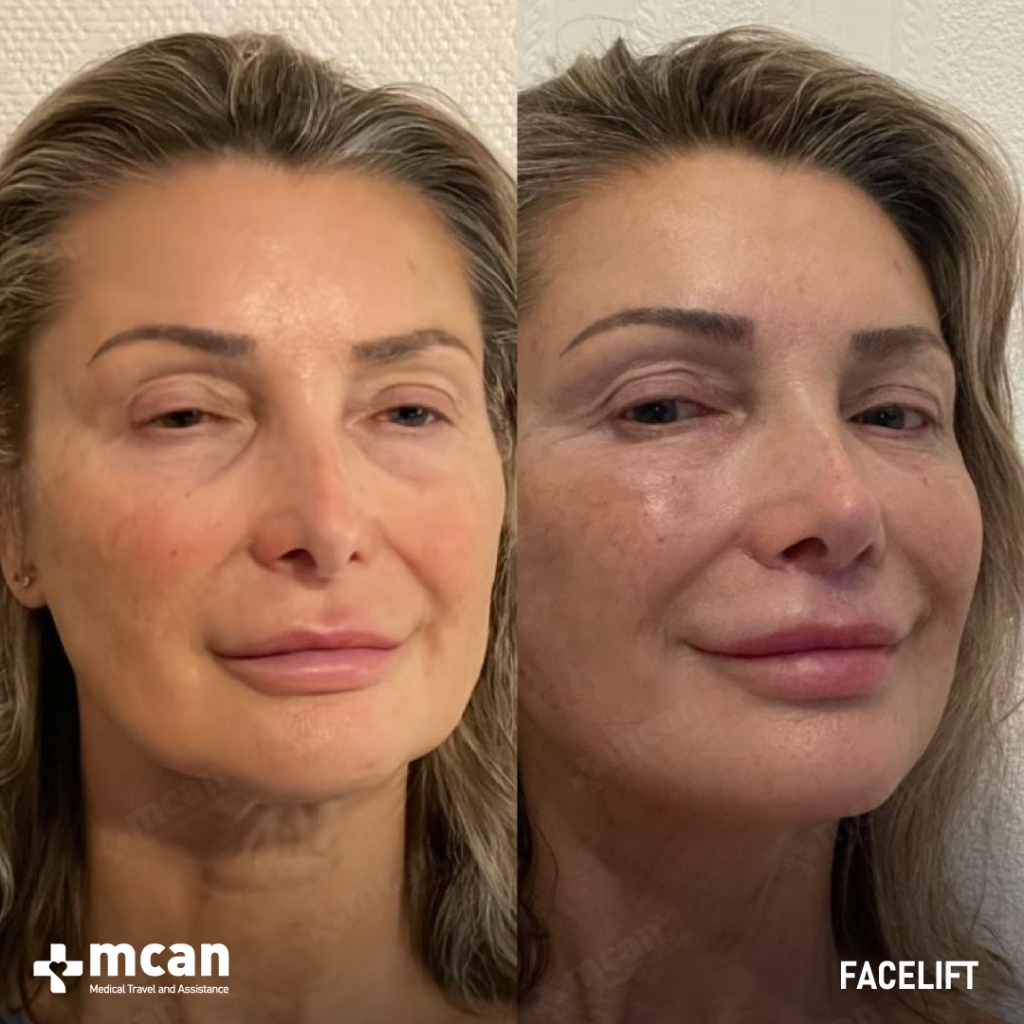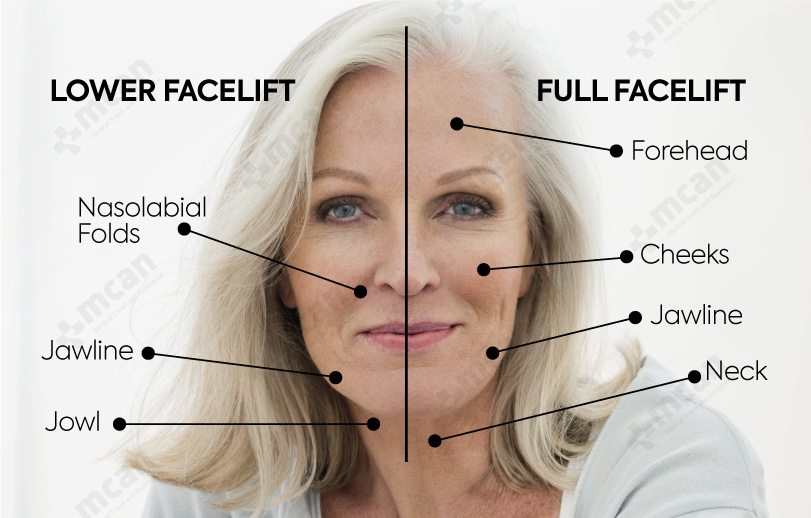
For many, a facelift can be the answer to restoring a youthful appearance by addressing sagging skin, deep lines, and other signs of aging that non-surgical treatments may not fully resolve. As with any surgical procedure, it’s essential to know what to expect, including the benefits, potential drawbacks, and what’s involved in recovery.
In this article, we’ll cover everything from the ideal timing for a facelift to the longevity of results, as well as common concerns and questions to help you make an informed choice.
What is a Facelift?
A facelift, or rhytidectomy, is a cosmetic surgical procedure aimed at reducing the visible signs of aging in the face and neck. This procedure works by lifting and tightening loose, sagging skin, as well as adjusting underlying muscles and tissues to give the face a smoother, firmer appearance. Facelifts can address concerns like deep creases around the mouth and nose, jowls, and excess skin on the neck. By restoring a more youthful contour, a facelift offers a refreshed look that helps patients feel more confident and rejuvenated without drastically changing their natural features.
In many cases, a facelift can be combined with other procedures, such as eyelid surgery or a brow lift, to enhance overall facial harmony. The procedure itself is tailored to each patient’s unique needs, allowing for adjustments based on skin type, age, and desired results. Recovery typically takes a few weeks, after which most patients enjoy long-lasting improvements that continue to look natural as they age.
Who is it for?
A facelift is ideal for those seeking to rejuvenate their appearance and regain confidence as signs of aging appear. While typically performed on individuals between 40 and 70, the best candidates meet certain criteria beyond age. Below is a quick guide to determine if a facelift may be suitable for you:
| Criteria | Facelift Eligibility |
|---|---|
| Age Range | Commonly performed on people aged 40–70, when skin elasticity and muscle tone naturally decline. |
| Overall Health | Candidates should be in good physical and mental health to ensure safe surgery and recovery. |
| Realistic Expectations | Ideal candidates understand that while a facelift can create a more youthful look, it cannot stop the aging process. |
| Non-Smoker | Non-smokers or those willing to quit before and after surgery are better suited, as smoking can interfere with healing and final results. |
| Concerns Addressed by Facelift | This procedure is suitable for those looking to improve loose skin, deep wrinkles, jowls, or sagging around the neck and jawline. |
A facelift can provide impressive results for those who meet these criteria, but consulting a qualified plastic surgeon is essential to ensure it aligns with your goals and health needs.
Signs It Might Be Time for a Facelift
Many people find that a facelift is the right solution when certain changes in their appearance begin affecting their confidence. If you’re noticing some of these common signs, a facelift might help you achieve a naturally rejuvenated look:
- Loose or Sagging Skin: Sagging skin around the cheeks, jawline, or neck can cause a tired appearance. A facelift can lift and tighten these areas, resulting in a smoother, more youthful look.
- Deep Lines and Wrinkles: Deep nasolabial folds, marionette lines, or other wrinkles that haven’t responded to fillers or non-surgical treatments may benefit from a facelift’s targeted approach to smoothing and lifting.
- Jowls: The development of jowls along the jawline is often hard to address with non-surgical options. A facelift can define the jawline, helping reduce the appearance of sagging in this area.
- Lack of Definition in the Neck: Loose skin around the neck, or a “turkey wattle” effect, can often be improved with a facelift, which enhances contours along the neck and jaw.
- Persistent Loss of Facial Volume: Age-related loss of fat can lead to a hollow, tired look. A facelift, sometimes combined with fat grafting, can restore volume and create a fuller, more refreshed appearance.
To see how transformative a facelift can be, take a look at one of our patients who had concerns about sagging in her cheeks and jawline, which had gradually affected her confidence.

With a personalized facelift, her features were gently lifted and defined, giving her a naturally youthful appearance that reflected how she felt inside. For more encouraging results like this one, you can check out our facelift before and after page.
Pros and Cons of a Facelift
A facelift can be a transformative procedure, offering long-lasting improvements for those seeking a rejuvenated appearance. However, as with any cosmetic surgery, it’s essential to weigh the benefits and potential drawbacks to determine if it’s the right choice for you. Below is a breakdown of the key pros and cons to consider:
| Pros | Cons |
|---|---|
| Long-Lasting Results A facelift provides years of improvement, making it a valuable investment in your appearance. | Surgical Risks There may be risks like infection, scarring, and anesthesia reactions, though a qualified surgeon can help minimize these. |
| Significant Improvement in Sagging Skin Effectively addresses sagging skin, providing a smoother, more youthful look. | Recovery Time Recovery can take several weeks, which may be challenging for those with busy schedules. |
| Natural-Looking Results Modern techniques allow for a natural, refreshed look without the “pulled” appearance of older methods. | Cost Facelifts are more costly than non-surgical treatments, though their longevity may make them worthwhile. |
| Boosts Confidence Enhances self-esteem, especially for those self-conscious about aging signs. | Not a Permanent Solution While long-lasting, a facelift doesn’t stop aging, and touch-ups may be desired over time. |
Ideal Timing for a Facelift
Determining the ideal timing for a facelift can greatly influence the success of your results. This timing depends on personal factors, including your age, aesthetic goals, overall health, and even seasonal preferences, as certain times of year may provide a smoother recovery experience. Many individuals consider a facelift when they notice more pronounced aging signs, such as skin sagging, deep wrinkles, and loss of facial definition. If you’re finding that these changes impact how you feel about your appearance, it might be a good time to explore the benefits of a facelift.
What is the best age for a facelift?
Most people choose to have a facelift between their mid-40s and late 60s, as this is when signs of aging become most visible. However, age is not the only factor; your skin quality, elasticity, and overall health also play a role. For some individuals in their 30s, a mini facelift may offer the subtle rejuvenation they desire, addressing early aging signs and maintaining youthful contours with a shorter recovery time. Those in their 60s or even 70s may benefit from a full facelift, provided they are in good health. Modern techniques have made it possible for patients of various ages to experience effective, natural-looking results.
What age is too late for a facelift?
There is generally no upper age limit for a facelift, as long as the patient is in good physical health and has realistic expectations about the outcomes. Many people in their 70s and even 80s undergo facelifts with satisfying results. The key factor is overall health rather than age. If you’re considering a facelift later in life, a consultation with a qualified plastic surgeon is essential. They will assess your health status, skin condition, and surgical goals to determine if a facelift is the right choice for you.
Age Guideline for Facelift Decision & Eligibility
Below you can find a guideline in which you can check your age and considerations before having a facelift:
| Age Group | Ideal Procedure | Considerations |
|---|---|---|
| 30s | Mini Facelift | Suitable for those noticing early signs of aging, such as mild sagging and fine lines. Offers subtle rejuvenation with shorter recovery time, helping maintain youthful contours. |
| 40s – Early 50s | Full or Mini Facelift | Ideal time for a facelift as signs of aging become more prominent, including deeper wrinkles and loss of skin elasticity. Skin quality and overall health are important factors. |
| Late 50s – 60s | Full Facelift | Common age for a full facelift to address pronounced aging effects like sagging skin and facial definition loss. Good health is essential for successful surgery and recovery. |
| 70s and Beyond | Full Facelift (based on health assessment) | No strict age limit; many patients in their 70s or 80s achieve good results. Health and skin condition take priority over age when considering suitability for the procedure. |
Is there a best time of year to have a facelift?
While a facelift can be performed at any time of year, some patients prefer fall or winter. Cooler weather during these seasons can aid in recovery by helping reduce swelling and allowing you to wear protective garments more comfortably. This timing also makes it easier to limit sun exposure, which is critical for proper healing. If you prefer to be more active in the warmer months, scheduling your facelift during the cooler seasons may give you ample time to fully recover and enjoy your results by spring or summer. Regardless of the season, prioritizing post-surgery care will help ensure a successful outcome.
Longevity and Worth of a Facelift
One of the significant benefits of a facelift is its longevity, often lasting 7 to 15 years or more, depending on your age, lifestyle, and skincare routine. Unlike temporary treatments like fillers or similar non-invasive treatments, a facelift provides structural improvements that make it a valuable investment in long-term facial rejuvenation. Here, we’ll explore the typical longevity of results and how to maintain them over time.
How does a facelift look after 10 years?
A decade after a facelift, many people still enjoy a noticeably youthful appearance. Though aging continues, a facelift can set back the clock, so you’ll likely look younger than if you hadn’t had surgery. Over time, you may notice some softening of results, as natural aging processes like gravity and collagen loss resume. However, most patients report that their facelift results remain beneficial well beyond the 10-year mark. Non-surgical treatments, such as skin tightening procedures, can complement your facelift results and extend their longevity.
Are facelifts worth the investment in the long term?
For those seeking a lasting solution to visible signs of aging, a facelift is often a worthwhile investment. While non-surgical treatments offer temporary results, a facelift provides substantial improvements that last for many years. Many patients find that the procedure’s cost is justified by the enhanced confidence and rejuvenation they experience, making it a long-term value. A highly qualified surgeon and adherence to recommended aftercare can help you get the most out of this investment.
Can a facelift affect your smile or eyes?
An expertly performed facelift is designed to enhance your features without altering the natural expressions that make you unique. The procedure targets sagging skin and loose muscles, which can subtly improve the look of your smile or eyes without drastically changing their shape. Occasionally, patients may notice very subtle adjustments in facial expressions due to the tightened skin. These changes are generally temporary and settle as your skin adapts to its new position. A skilled surgeon will focus on creating harmony with your natural facial contours to preserve your unique look.
Common Concerns and Questions About Facelifts
If you’re considering a facelift, you may have questions about the procedure’s effects, potential risks, and other details that could influence your decision. Addressing these questions can give you greater clarity about the process and what to expect.
Can a facelift go wrong?
As with any surgical procedure, a facelift does come with potential risks. These may include infection, scarring, nerve damage, or asymmetry. However, complications are rare, especially when the procedure is performed by a skilled, board-certified plastic surgeon. The best way to minimize these risks is to select an experienced surgeon and follow all pre- and post-operative instructions. You’ll also have follow-up appointments to monitor your progress and address any concerns promptly.
Here’s what you need to know after getting a facelift in Turkey
Can you tell if someone has had a facelift?
A well-done facelift by an experienced surgeon should be nearly undetectable. Instead of making you look “done” or stretched, modern facelifts aim to create a refreshed, well-rested appearance. Subtlety is the goal, with most people commenting that you look younger or more rejuvenated without suspecting surgery. The techniques used today focus on restoring a youthful look that complements your natural facial structure, allowing you to enjoy the results without others noticing you had a procedure.
Why do eyes sometimes appear smaller after a facelift?
Sometimes, slight tightening of the skin can cause a subtle change in how the eyes appear, as the cheek and jawline skin adjusts to its lifted position. This effect, however, is typically minimal and temporary. As your face settles over the following weeks, the area around your eyes will relax, and any subtle changes in appearance usually diminish. Surgeons prioritize maintaining your natural eye shape by carefully evaluating each patient’s unique facial structure and planning accordingly.
Is a facelift a permanent solution?
While a facelift offers long-lasting results, it does not stop the natural aging process. Over time, some signs of aging may reappear, but you will continue to look younger than you would have without the surgery. For most, a facelift effectively “resets the clock,” allowing you to enjoy a refreshed look for years. Non-surgical treatments can help maintain the results, offering subtle refinements to extend the youthful effects of your facelift.
Why Choose MCAN Health for a Facelift?
MCAN Health in Turkey offers expert facelift services with a focus on quality, safety, and personalized care. Our experienced, board-certified surgeons use advanced techniques to achieve natural, tailored results. Facelifts are performed in fully accredited, modern facilities designed for patient comfort and optimal outcomes.
We prioritize affordability and transparency, allowing international patients to access high-quality facelifts without hidden fees. Throughout your journey, our dedicated team provides full support—from consultation to recovery. With a strong reputation and glowing patient testimonials, MCAN Health is a trusted choice for facelifts in Turkey.


 Barbie Nose vs Natural Nose Job
Barbie Nose vs Natural Nose Job  In Which Stages of Gyno Are You?
In Which Stages of Gyno Are You?